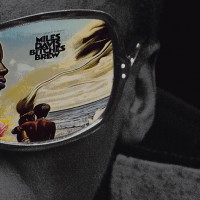Some twenty-five years ago when compact discs began to overtake vinyl as the music media of choice, I joined one of those mail-order record clubs as a way to quickly build up a foundation for my fledgling CD collection. One of the genres I was particularly interested in getting bulked up in was rock-jazz fusion, but alas, the pickings were slim, just regulated to a few of the obvious choices and a smattering of contemporary selections they were really of the “smooth jazz” variety.
I can still recall finding in a catalog for the Columbia House record club the entry for one of the few of those obvious selections, Miles Davis’ classic 1970 release Bitches Brew. It was described by the catalog as “the first shot fired in the fusion wars.” The implication by that claim is that Bitches Brew was the first fusion album, and while it was the first fusion album that became famous for being a fusion album, it wasn’t the first album in that style of music. Even Miles himself had the equally amazing In A Silent Way preceding it.
Truth is, the road to Brew began at least since way back in 1956, when Sun Ra’s “India” featured an electric Wurlitzer piano, one of the first times a plugged-in instrument was played on a jazz song. But things really got ramped up in the middle to late sixties, when bands like the Paul Butterfield Blues Band, the Doors and even the Byrds began to adapt John Coltrane’s jam-friendly modalism into their own brand of blues, folk and rock. Meanwhile, the jazz guys were starting to listen to rock and R’n’B records and incorporating some of those aspects, the most notable example being the soul serum Joe Zawinul-penned classic “Mercy, Mercy, Mercy” originally performed by Cannonball Adderley’s quintet in 1966. It’s also notable that before 1970, Blood, Sweat & Tears already had two albums out; they were pioneers in incorporating a jazzy horn section into a rock band.
Here’s a list of fusion jazz records that preceded Bitches Brew that were among the best of that exciting early period, offering plenty of evidence that Miles didn’t paint his masterpiece on a blank canvas:
Gary Burton Quartet – Duster (1967): This would be what I’d call the first true fusion album. It’s not “jazzy” rock nor “rock-ish” jazz, it truly is a blend of both and not falling entirely on either side. Burton’s songs were already not following the typical swing pattern of jazz all that closely but when he added an electric guitar player, Larry Coryell, into his group, it was a game changer. Coryell came over from what some call the first-ever fusion group, The Free Spirits, and he brought his rock-jazz inclinations along with him. Put in a group with serious jazz credentials — joining Coryell and the vibes maestro Burton were bassist Steve Swallow and drummer Roy Haynes — Coryell nudged the quartet closer to the rock side. Enough so that it put the band into new territory; “General Mojo’s Well Laid Plan” and “One, Two, 1-2-3-4” foretold what was in store for this new style of music a few years later.
Coryell, the father of fusion guitar, wasn’t done charting this new direction in music, however…
Larry Coryell – Spaces (1969): After leaving Burton’s quartet in 1968, Coryell began his solo career and quickly issued two albums of mostly instrumental jazz-rock, but Lady Coryell and Coryell, while good, wasn’t the artistic peak that he achieved with Spaces. A rangy record that’s bound together by uncommonly good lyricism and superb playing, it reaches back to Django Reinhardt’s prewar swing (“Rene’s Theme”) and forward to an avant-garde reading of Scott LaFaro’s “Gloria Step” (with Miroslav Vitous on cello). John McLaughlin joins Coryell and trades licks with him on three tracks in an epic head-to-head meeting of two the most important six-string architects of fusion. Along with McLaughlin, another Bitches Brew participant Chick Corea lends an electric piano to “Chris,” which would have been right at home on Miles’ brilliant 1968 transitional platter Filles de Kilimanjaro.
Tony Williams Lifetime – Emergency!(1969): When Tony Williams formed Lifetime after leaving Miles’ quintet in late 1968, he set out to do to jazz what Led Zeppelin was doing to the blues at the same time: make it heavier and louder. While the product of Zep’s hybrid became known as heavy metal, Williams’ experimentation formed the genesis for a lot of the intense, lick-based hard fusion that characterized the form throughout much of the following decade. None of them did it as provocatively and explosively as Williams’ group. With McLaughlin and organist Larry Young on board, this may have been the first rock-jazz supergroup, a power trio to the nth degree. With Williams’ ridiculously impossible trap kit convulsions, Young’s mammoth organ fills and McLaughlin never sounding so unencumbered, the band strongly suggested what could have been had Jimi Hendrix had been able to fully indulge his nascent fusion leanings.
The recording quality is notoriously crappy but it hardly takes any edge off of the performances. The original lineup would be largely gone by 1971 but the Lifetime unit Tony Williams put together with McLaughlin and Young was greatly influential and a force to be reckoned with, lack of longevity and decent recording equipment be damned.
Frank Zappa – Hot Rats (1969): Zappa had touched on jazz-rock plenty of times before and since, but Hot Rats is where he made it a focus. And he did it first class all the way, from the advanced recording techniques, to the intricate arrangements (especially the shorter pieces, like the evergreen classic “Peaches En Regalia”) to a using a group of first-rate musicians like Jean-Luc Ponty, Don “Sugarcane” Harris, Ian Underwood and pre-Little Feat Lowell George. This was also Zappa’s first full flowering as a guitarist to be reckoned with, something we made note of on a long-ago study of “Willie The Pimp.” For Frank Zappa with all of the virtuosity and ingenuity and almost none of the silliness, Hot Rats is hard to beat.
Jean-Luc Ponty – King Kong: Jean-Luc Ponty Plays the Music of Frank Zappa (1969): Around the same time Zappa made Hot Rats, he served as the linchpin behind Ponty’s earliest fusion record, one that’s nothing like any record Ponty made on his own. Produced by Zappa with all compositions entirely by Zappa — excepting the Ponty co-write “How Would You Like To Have A Head Like That?” — this is in many ways a Zappa record channeled through the highly accomplished violin of Ponty. On the other hand, it’s unlikely that any other violinist, even Sugarcane, could realize Frank’s complex, contorted, but also colorful musical vision so well. Even Zappa’s hastily-written symphony “Music for Electric Violin and Low Budget Orchestra” is full of interesting moments and providing key support is a young George Duke on keyboards and Ernie Watts on sax. Although he’d go on to make some fusion records that many consider to be classic of the genre (like, say, Enigmatic Ocean), King Kong remains Ponty’s high point, and arguably, Zappa’s too.
[amazon_enhanced asin=”B0001926OI” /] [amazon_enhanced asin=”B000000EL6″ /] [amazon_enhanced asin=”B0000047GA” /] [amazon_enhanced asin=”B008BDZP3K” /] [amazon_enhanced asin=”B000005HE8″ /]



